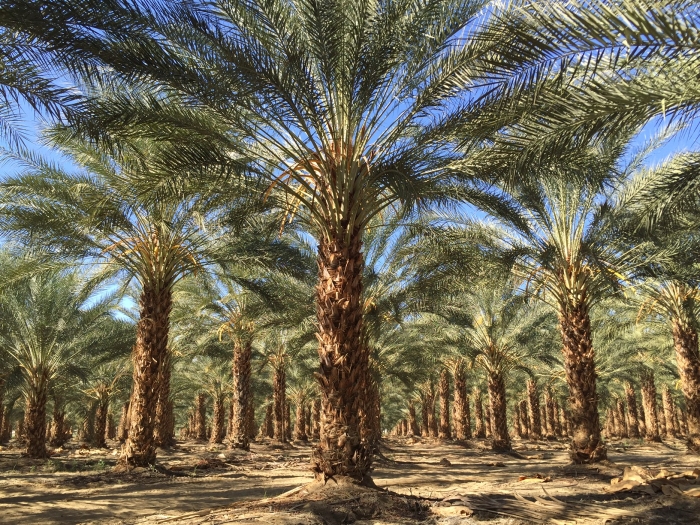Date Palm
(Phoenix dactylifera)
Date Palm (Phoenix dactylifera)
/
/

Southcoastwholesale
CC BY-SA 4.0
Image By:
Southcoastwholesale
Recorded By:
Copyright:
CC BY-SA 4.0
Copyright Notice:
Photo by: Southcoastwholesale | License Type: CC BY-SA 4.0 | License URL: https://creativecommons.org/licenses/by-sa/4.0 | Uploader: Southcoastwholesale | Publisher: Wikimedia Commons | Title: Phoenix_Dactylifera_Date_Palm_Fields_South_Coast_Wholesale.jpg | Notes: Transferred from Flickr via #flickr2commons |









































































Estimated Native Range
Summary
Phoenix dactylifera, commonly known as Date Palm, is an evergreen tree native to arid deserts and oasis environments in North Africa, the Arabian Peninsula, and parts of Western Asia. It is a staple in desert agriculture, valued for its sweet fruit and ornamental qualities. Date Palms can reach up to 30 meters (100 ft) in height, often growing in clumps with several stems from a single root system. They are slow-growing and long-lived, with some specimens reaching over a century in age. The tree’s form is characterized by a stout trunk and a crown of arching, pinnate fronds. Dates are oval-cylindrical, 3 to 7 centimeters (1 to 3 in) long, with a color ranging from bright red to bright yellow depending on the variety.
Date Palms are cultivated for their edible fruit and as ornamental trees in landscapes. They are particularly noted for their drought tolerance and are used in urban plantings, as well as in private gardens for their striking appearance. Date Palms require well-drained deep sandy loam soils with a pH of 8–11 (alkaline) and can tolerate soils with low organic content. They thrive in full sun or part shade and need low amounts of water once established. It takes 4 to 8 years after planting for Date Palms to bear fruit, with commercial yields starting between 7 and 10 years. Mature trees can produce 70–140 kg (150–300 lb) of dates per harvest season. Cultivation practices include thinning and bagging the fruit bunches to ensure quality. Phoenix dactylifera can become invasive in suitable climates outside its native range, so caution is advised when planting it in such areas.CC BY-SA 4.0
Date Palms are cultivated for their edible fruit and as ornamental trees in landscapes. They are particularly noted for their drought tolerance and are used in urban plantings, as well as in private gardens for their striking appearance. Date Palms require well-drained deep sandy loam soils with a pH of 8–11 (alkaline) and can tolerate soils with low organic content. They thrive in full sun or part shade and need low amounts of water once established. It takes 4 to 8 years after planting for Date Palms to bear fruit, with commercial yields starting between 7 and 10 years. Mature trees can produce 70–140 kg (150–300 lb) of dates per harvest season. Cultivation practices include thinning and bagging the fruit bunches to ensure quality. Phoenix dactylifera can become invasive in suitable climates outside its native range, so caution is advised when planting it in such areas.CC BY-SA 4.0
Plant Description
- Plant Type: Tree
- Height: 50-100 feet
- Width: 20-40 feet
- Growth Rate: Slow
- Flower Color: N/A
- Flowering Season: Spring, Summer
- Leaf Retention: Evergreen
Growth Requirements
- Sun: Full Sun
- Water: Low
- Drainage: Fast
Common Uses
Bird Garden, Drought Tolerant, Edible*Disclaimer: Easyscape's listed plant edibility is for informational use. Always verify the safety and proper identification of any plant before consumption., Low Maintenance
Natural Habitat
Arid deserts and oasis environments
Other Names
Common Names: Date , Nakhl , Dattelpalme , Dattel-Palme , Palmera Datilera , Palmier Dattier , Dattier , Dadel , Tamareira , Dadelpalm
Scientific Names: Phoenix dactylifera , Palma major , Encephalartos pungens , Phoenix iberica , Phoenix excelsior , Zamia pungens , Macrozamia tridentata var. pungens , Palma dactylifera , Palma major oppr , Phoenix atlantica var. maroccana
GBIF Accepted Name: Phoenix dactylifera L.